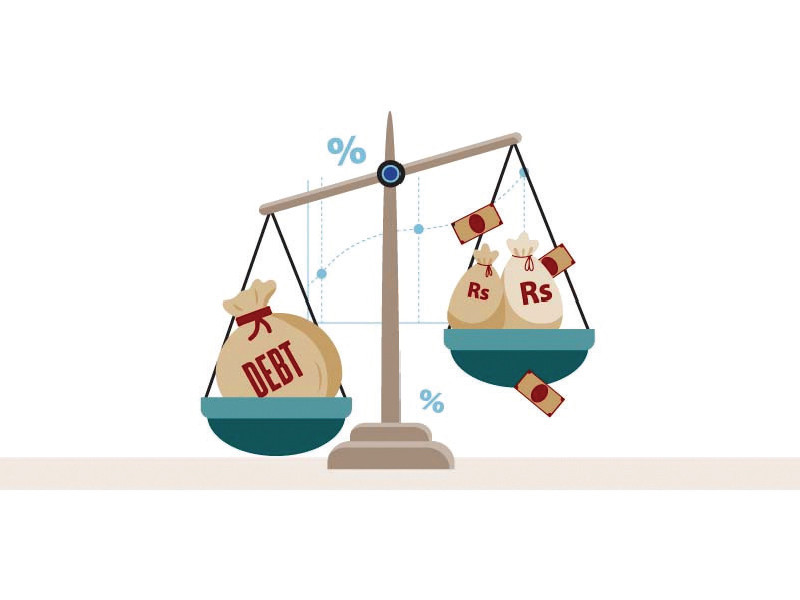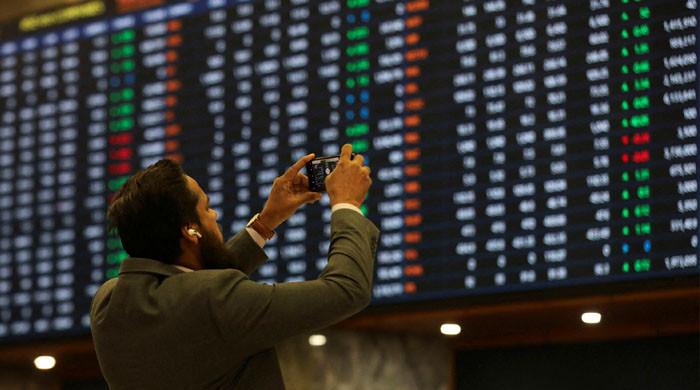ISLAMABAD:
As Pakistan’s public and guaranteed debt has surged to a record Rs74.6 trillion by the end of June, a new report by the Finance Ministry assesses that in case of any new macroeconomic and fiscal shock the debt and financing needs would jump to unsustainable levels”.
The Ministry of Finance’s Debt Sustainability Analysis report for 2025-27 reveals that due to the high level of debt burden and the consequent gross financing requirements, Pakistan remains exposed to various debt sustainability-related risks.
“The debt profile is sustainable over the medium, however, faces significant risks from external shocks and structural vulnerabilities, particularly due to a high proportion of external and floating-rate domestic debt,” shows the report.
The report details that Pakistan’s total public and publicly guaranteed debt has risen substantially, standing at Rs74.6 trillion at the end of June 2024, according to the finance ministry. During the past fiscal year, the public debt burden increased by Rs8.2 trillion, or 12.3%, equating to 70.5% of the GDP. According to the Debt Limitation Act, the debt-to-GDP ratio should have been below 57.5%.
This higher-than-statutory debt limit indicates that Pakistan’s debt burden is unsustainable. However, the International Monetary Fund (IMF) continues to declare it sustainable to avoid the need for immediate domestic and foreign debt restructuring.
The finance ministry report further states that the significant increase in public debt was primarily due to the financing of the federal fiscal deficit, with interest expenses being a major component. In the baseline scenario, the finance ministry projects that the debt-to-GDP ratio will follow a downward trajectory from FY2025 to FY2027, ranging from 68.5% to 66.4%. However, this optimistic outlook is threatened by the potential for a combination of fiscal and macroeconomic shocks, which could push the ratio above 70%, jeopardising debt sustainability.
In a combined macro-fiscal shock scenario, the debt-to-GDP ratio could exceed the 70% threshold, risking debt sustainability, according to the finance ministry. In addition, a macro-fiscal shock could cause the debt-to-GDP ratio to reach 75%, which is 8.6% above the baseline scenario.
As a result, the total financing requirements of the Pakistani government would range around 22.6% of the GDP3.2% higher than the baseline assumption. For a developing country like Pakistan, financing requirements of 15% of the GDP are considered manageable.
The finance ministry warns that lower-than-expected economic growth, a rise in the primary deficit, an increase in real interest rates, a surge in contingent liabilities, and exchange rate depreciation could significantly increase public debt and gross financing needs, both as a ratio of GDP, over the medium term.
The report also notes that Pakistan’s external debt is mostly obtained from concessional bilateral and multilateral sources. Although the maturity structure is expected to extend over the three-year horizon, the growing share of short-term debt in recent years poses risks to debt sustainability due to high refinancing risk, further increasing gross financing needs.
Within the external debt portfolio, fixed-rate debt accounts for 63% of total external debt, while floating-rate debt accounts for 37%. Meanwhile, domestic debt, which constituted 66.2% of the total public debt by the end of June, largely has long-term maturity. However, the large share of floating-rate debt within domestic debt poses a significant interest rate risk, according to the finance ministry. Fixed-rate debt accounts for 26% of total domestic debt, while floating-rate debt accounts for 74%.
Baseline scenario
In the baseline scenario, the finance ministry assumes that the economy will grow by 3.6% in FY2025. Inflation may average 12% for FY2025 before reaching single digits in FY2026. The exchange rate stabilised in FY2024 against the backdrop of a favorable current account balance and is projected to remain stable over the medium term. In alignment with the government’s fiscal consolidation efforts, the federal primary balance is projected to improve significantly during FY2025-27.
Shock scenario
The finance ministry states that due to limited fiscal space, a sudden shift in the primary balance is not beyond expectation. If a shock occurs in the primary balance, increasing the primary deficit close to historical levels, the debt-to-GDP ratio will exceed the 70% benchmark, risking debt sustainability.
The finance ministry adds that if economic growth remains at 2.6% in this fiscal year, the debt-to-GDP ratio will surpass the 70% benchmark and may reach 70.6% in fiscal year 2027. The adverse GDP growth shock will persistently keep the debt-to-GDP ratio at 70% or higher over the medium term.
The large share of floating-rate debt within domestic debt also makes domestic debt vulnerable to nominal interest rate shocks. With low foreign exchange reserves and scarce market financing, nominal interest rates could adversely impact debt-to-GDP ratios.
The high share of external debt poses additional risks to debt sustainability through exchange rate depreciation. Although Pakistan’s capacity to repay its external debt obligations remains adequate, it is subject to risks from inadequate export receipts, rising imports, and a deteriorating current account balance, which may exert pressure on the exchange rate, said the finance ministry.


 Technology6 مہینے ago
Technology6 مہینے ago
 Pakistan7 مہینے ago
Pakistan7 مہینے ago
 Sports6 مہینے ago
Sports6 مہینے ago
 Pakistan6 مہینے ago
Pakistan6 مہینے ago
 Entertainment6 مہینے ago
Entertainment6 مہینے ago
 Pakistan6 مہینے ago
Pakistan6 مہینے ago
 Sports5 مہینے ago
Sports5 مہینے ago
 Entertainment6 مہینے ago
Entertainment6 مہینے ago








